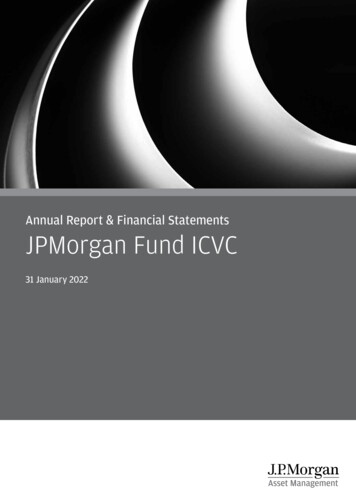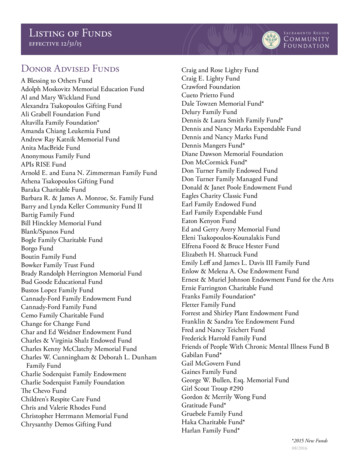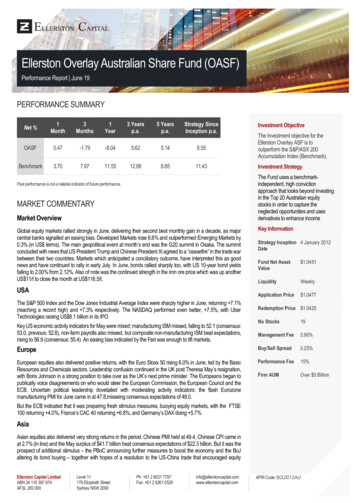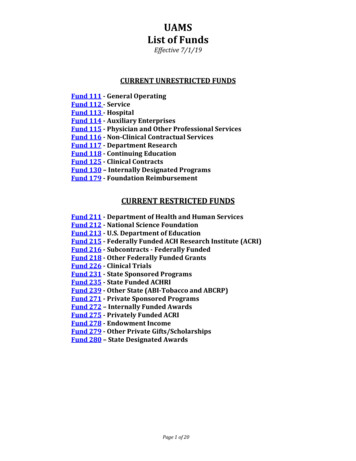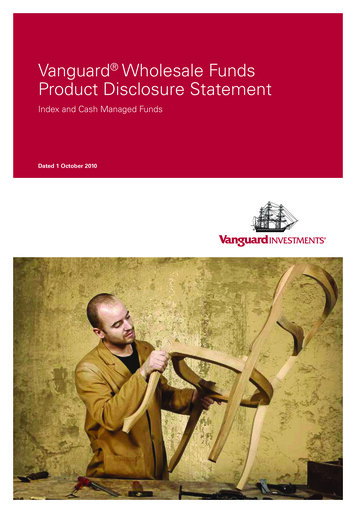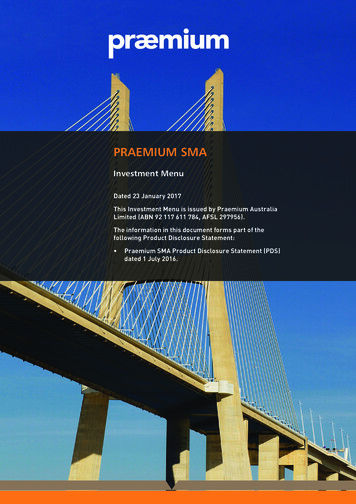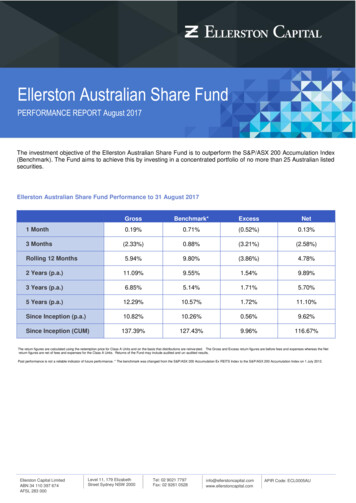
Transcription
Ellerston Australian Share FundPERFORMANCE REPORT August 2017The investment objective of the Ellerston Australian Share Fund is to outperform the S&P/ASX 200 Accumulation Index(Benchmark). The Fund aims to achieve this by investing in a concentrated portfolio of no more than 25 Australian listedsecurities.Ellerston Australian Share Fund Performance to 31 August 2017GrossBenchmark*ExcessNet1 Month0.19%0.71%(0.52%)0.13%3 Months(2.33%)0.88%(3.21%)(2.58%)Rolling 12 Months5.94%9.80%(3.86%)4.78%2 Years (p.a.)11.09%9.55%1.54%9.89%3 Years (p.a.)6.85%5.14%1.71%5.70%5 Years (p.a.)12.29%10.57%1.72%11.10%Since Inception (p.a.)10.82%10.26%0.56%9.62%Since Inception (CUM)137.39%127.43%9.96%116.67%The return figures are calculated using the redemption price for Class A Units and on the basis that distributions are reinvested. The Gross and Excess return figures are before fees and expenses whereas the Netreturn figures are net of fees and expenses for the Class A Units. Returns of the Fund may include audited and un-audited results.Past performance is not a reliable indicator of future performance. * The benchmark was changed from the S&P/ASX 200 Accumulation Ex REITS Index to the S&P/ASX 200 Accumulation Index on 1 July 2012.Ellerston Capital LimitedABN 34 110 397 674AFSL 283 000Level 11, 179 ElizabethStreet Sydney NSW 2000Tel: 02 9021 7797Fax: 02 9261 comAPIR Code: ECL0005AU
Market CommentaryThe equity markets kicked off on a reasonably positive note in August, with key indices such as the S&P500 hitting newrecord highs, at least until investors quickly pressed the 'risk-off' button as geopolitical tensions in the Korean peninsulaescalated. US Equities finished August higher, with the Dow Jones ( 0.65%) and S&P 500 ( 0.3%) notching five-monthwinning streaks, and the Nasdaq recording its 9th positive month of the last 10. US/North Korean tensions further ratchetedup, with President Trump warning North Korea about facing “fire and fury” if the regime of Kim Jong-un continuedthreatening the US. North Korea responded by saying it was “carefully examining” its strategy of a missile strike on theisland of Guam. Towards month end, North Korea tested a missile which travelled over Japan’s northernmost island,Hokkaido. President Trump's continuing political battles and Hurricane Harvey in the Gulf didn't help sentiment.Against this backdrop, in Europe, the Euro Stoxx 50 Index (-0.7%) floundered while Asian equities were mixed throughAugust. The Nikkei 225 fell 1.4%, whilst Singapore and Korean markets both fell 1.6% respectively. Hong Kong’s HangSeng was the best performer, finishing 2.4% higher, despite the arrival of Tropical Cyclone Hato.Emerging markets also outperformed (MSCI World Emerging Markets index 2.1%), aided by rising commodity prices.The main feature in commodity markets during the month was the sharp rally in base metal prices, with aluminium, copper,nickel and zinc hitting multi-year highs on optimism around synchronized global growth, ongoing supply constraints anda weakening U.S. Dollar. Not surprisingly, the gold price rallied in August to close at a 9 month high of US 1,321/oz, asUS/North Korean tensions persisted and investors rushed into the yellow metal as a store of value/safe haven.Economic data was generally supportive, as the OECD noted that all 45 countries it tracks were poised to growthis year, the first period of synchronised growth since 2007. In the US, employment remained strong, as non-farmpayrolls for July rose a stronger-than-expected 209,000 (consensus 180k) and the unemployment rate fell to 4.3%. TheCPI for July also rose a weaker-than-expected 0.1%m/m (vs. consensus 0.2%). Real GDP for Q2 was revised up to abetter-than-expected 3.0%q/q annualised (consensus: 2.7%) from a previously estimated 2.6% print.In Europe, activity indicators were also strong, with the flash Eurozone manufacturing PMI for August rising to a strongerthan-expected 57.4 (consensus: 56.4).The Australian equity market absorbed an incredibly volatile reporting season, bouncing off an index low of circa 5,680five times through the month, but also failing to break the 5,800 point threshold on the upside. The S&P/ASX200Accumulation Index finished 0.71%, but with significant variation between sector returns. The positive August totalreturn was due entirely to the 80bps dividend contribution, with the ASX200 price index falling 0.1% in the period.Energy ( 5.7%), Consumer Staples ( 5.3%), Industrials ( 4.6%), Materials ( 4.6%) and Utilities ( 3.2%) were thebest performing sectors. Materials added the most value in August, largely driven through the Miners (BHP Billiton, RioTinto, Newcrest Mining), with support from the Energy ( 23 bps), Consumer Staples ( 38 bps) and Industrial ( 33 bps)sectors. Financials (-82 bps) provided the largest drag on performance, with Banks (-72 bps) and Insurance (-16 bps)accounting for most of the sector losses.The domestic reporting season was primarily one of missed expectations. The ratio of misses to beats stood at 1.3x, with the average EPS miss being penalized by -3.8% on results day. At the top line, 16% of companies beat onrevenue, while 22% missed. Most importantly, of the ASX 200 stocks that reported, 55% provided guidance, of which44% triggered FY18e EPS downgrades, versus only 27% of stocks that received an upgrade.Company Specific NewsThe MissesVocus (VOC -33.8%)In early June, KKR made an indicative offer for Vocus at 3.50. After a month of consultation, KKR was granted accessto conduct due diligence which also attracted Affinity Equity Partners to the table. However in what is becoming an all toocommon event, a deal failed to consummate, leaving shareholders with more questions than answers.Mayne Pharma (MYX -30.2%)MYX collapsed after missing guidance that was issued just a fortnight before announcing its results. The Teva USgenerics business, which was acquired in July 2016, is facing material pricing pressure post recent tenders by the largestbuyers in the industry. The 2018 year will be another challenging one and the market cut earnings estimates by 10-12%.2
Isentia Group (ISD -20.7%)Perennial downgrade offender Isentia issued yet another profit warning, with a revised EBITDA of 41.5m compared toprevious guidance of circa 44m. The downgrade was driven by bad debts in Asia, adverse FX impacts and losses fromContent Marketing. In addition, the company fully wrote-down the value of King Content.Domino’s Pizza (DMP -18.2.%)Domino’s long-run of managing and beating market expectations came to a spectacular halt in FY17, missing its 30%growth target by 2% and consensus by 4%. Issues in its French operations caused most of the shortfall. Compoundingthe impact, the company guided to ‘only’ 20% growth in FY18 vs. consensus expectations of 30%. The once highly ratedname was savaged, finishing down 19% on the day.Trade Me (TME -17.6%)TME consolidated on a good first half to deliver FY17 adjusted NPAT up 12% at NZ 93m, with pre-associate EBITDA up9%. Divisional highlights were Jobs (revenue 25%) and Marketplace ( 7%), although GMS slowed considerably in2H. The negative surprise of the day was the outlook comments, with TME announcing it will invest in a range of platformcentric initiatives, with costs expected to outgrow revenue in FY18.Bluescope Steel (BSL -17.5%)Bluescope reminded the market that it is a cyclical and operationally leveraged company, with guidance for 1H18 comingin some 20% below the market’s expectations. An uncertain US steel market, continued dumping of product in Australiaand higher domestic energy costs all contributed to the soft outlook.Japara Healthcare (JHC -17.2%)Whilst the headline number was in line with guidance, JHC reported a disappointing underlying FY17 result, with thereported EBITDA of 60.2m being boosted by circa 5m of profits on property sales treated above the line. Given theimpacts of funding changes (freeze to ACFI indexation and reduced complex patient re-imbursement), the company hasguided to flat earnings in FY18.iSelect (ISU -17.3%)iSelect reported EBIT at the low end of guidance at 22.5m vs consensus at 24m, blaming weaker revenue from theenergy and telco sectors which adversely impacted the company.Healthscope (HSO -16.4%)One of our core stocks, HSO delivered an FY17 result that was broadly in line with market expectations. However, theshare price fell sharply due to the surprisingly weak FY18 guidance, where the company stated that expected EBITDAfrom the hospital division was expected to be flat. The hospital division has been impacted by two specific factors thatwill impact FY18, the first is a much slower ramp up at the new Holmesglen and Frankston facilities in Victoria and thesecond being higher wages inflation in that state. The net result was the market downgrading earnings for the companyby circa 10% in FY18.Chorus (CNU -12.3%)Chorus reported EBITDA of NZ 652m which was in-line with expectations, however higher depreciation charges deliveredan NPAT figure of just NZ 113m, which was 10% below street expectations. That, combined with FY18 guidance thatwas circa 5% below consensus, precipitated the sharp fall.Sigma Health (SIG -10.9%)Early in the month, Sigma downgraded FY18 earnings guidance due to sales weakness, primarily in the consumerproducts sold to pharmacy customers. The company now expects EBIT to be 90m in FY18, down 11% on the 101mreported in FY17.QBE Insurance (QBE -10.1%) It’s deja vu all over again. QBE delivered a result in-line with lowered guidance, but thequality of the result was poor. Higher reserve releases than previously guided flattered the numbers. However, thecompany downgraded the outlook again with a higher (worse) combined ratio now expected. The emerging market bookalso suffered unexpected losses, prior year reserve releases were expected to be lower, and the US crop book was worsethan expectations. Forward earnings were downgraded between 6% and 12%. The company commenced its share buyback, but this had little impact as management’s credibility is on the line and has been significantly tarnished.James Hardie (JHX -7.7%)JHX reported 1Q18 NPAT of US 61.1m, down 8.4% on pcp. The weaker than expected result was driven by poor plantperformance and much higher-than-expected manufacturing costs in North America, where EBIT fell to US 79.8m, down15.6% on pcp. This was the fourth earnings miss in a row and is testing investor patience. The outlook commentary wasalso disappointing, with management describing the 2Q forward order file as “soft”.3
Sirtex (SRX -6.8%)SRX delivered a very messy FY17 result that at an underlying level, missed the EBITDA guidance only provided in lateJune. At a reported level, the company delivered a loss of 26.3m, driven by a 90m charge relating to R&D write-offs,restructuring charges and impairments. Post the result, consensus earnings expectations for FY18 were downgraded byover 10%.Telstra (TLS -6.6%)Management at Telstra spent the last 9 months working on a capital management plan that would endure through thetumultuous NBN migration. The outcome was underwhelming, with the projected annual dividend cut to 22c supportedby the securitisation of the NBN compensation payments. That plan was thrown into turmoil at the end of the month asNBN Co. rejected Telstra’s securitisation plan.Suncorp Group (SUN -6.0%)SUN’s result disappointed and contained an unexpected additional 100 million after- tax spend on its “Marketplace”strategy in FY18. Not only is the market sceptical on the strategy, it was surprised by the additional spending earmarkedfor “knock-out” applications, brand refresh and the like. General insurance margin targets also appeared more difficult toachieve. The end result was material earnings downgrades (up to double digits) to earnings looking out.IAG Group (IAG -3.9%)IAG’s results were also weaker in the 2H relative to expectations, with underlying insurance margins down to 11.2%, off140 basis points on 1H. The company attributed the weaker 2H result to adverse commercial loss experience, claimsinflation in motor insurance and higher allowance for natural perils in the year. IAG is a high quality business that wastrading on a high multiple and the miss was accordingly marked down by the market.Magellan (MFG -4.6%): MFG was impacted by results slightly below expectations and higher ongoing employee andmarketing costs and costs relating to the new listed vehicle (Magellan Global Trust) which is part of the company’scontinued push into the retail market. The company also announced its intention to close the global equities strategies toinstitutional flows. A premium stock on a premium multiple clearly suffering from some growth adjustments.Ramsey Healthcare (RHC -3.2%)RHC reported an FY17 result up 13%, which was in line with guidance. The result however, was weak at the operationalline, with the Australian hospital division lighter than expected and only a lower tax rate getting it across the line. Outlookguidance was for 8-10% earnings growth in FY18, which is below the historic levels of low teens. A combination ofdeclining earnings from France and the UK (lower tariffs / re-imbursements) and currency headwinds resulted in circa 35% earnings downgrades.Resmed (RMD -0.1%)RMD reported its second poor quarter in succession. The disappointment was driven by a combination of lower grossmargins and softer mask sales growth (especially in the USA). Analysts reduced expectations for FY18 by circa 5% postthe resultsThe HitsBlackmores (BKL 27.7%)Whilst BKL reported an FY17 result of 59m (down 41% on pcp), the Q4 result was actually the strongest in the last 12months. Q4 sales grew by 6%, cycling a strong pcp and excluding one-off provisioning, underlying EBIT fell by 7.5% inthe quarter. This suggests that the business has started to find a base after a very challenging FY17. The share pricerallied on the back of the result, as the market was fearing a continuation of the weak past 9 months performance.Mineral Resources (MIN 23.5%)Whilst the resources sector in general enjoyed a positive reporting season, the top gong went to MIN. Not only did itdeliver strong FY17 results, but an upgrade to its total resource and positive FY18 EBITDA guidance of a minimum of 500m in EBITDA easily surpassed expectations and helped buoy the stock.A2 Milk (A2M 21.7%)A2 Milk delivered an outstanding result with NPAT of 90.6m, up 198% on pcp and circa 5% above marketexpectations. The key feature of the result was very strong infant formula sales, which drove a significant increase ingross margins that dropped through to the bottom line. Given a strong net cash balance sheet, the company alsoannounced a modest 40m buyback.Asaleo Care (AHY 20.8%)Asaleo reported 1H17 EBITDA of 60.9 million, up 4%, with the result characterized by modest sales growth, but loweroperating costs. The company maintained its previous earnings guidance despite facing higher electricity prices, whichhave been partially offset by lower input costs (pulp) and a higher A.4
Treasury Wine Estates (TWE 20.0%)TWE earnings continued to surge ahead driven by cost savings and strong demand for its premium red wines in China.A surprise buyback of 300m and an aspirational target to grow EBIT margins to 25% over time drove the stock to newrecord high levels.Whitehaven Coal (WHC 17.9%)WHC benefitted from higher coal prices and is now in a strong financial position, with operating cashflow in 2H17 jumpingto 370m. With coal prices maintaining a stunning run throughout August and a growing expectation for WHC to payoutall ongoing excess cash, patient shareholders are finally being well rewarded.Orora (ORA 12.3%)Orora reported an underlying net profit of 186.2m in FY17, up 10% on pcp and ahead of the market forecast of 180m.Australasian earnings of 214m were up 7% on pcp while North American earnings of 117.5m were up 19% on pcp. Thecompany has guided to underlying earnings growth in FY18 in constant currency terms, subject to global economicconditions.Medibank (MPL 11.8%)MPL delivered an operating result of 497m which was modestly above previous guidance of 490m. The features of theresult were stronger gross margins, which were partially offset by higher expenses. Whilst customer numbers continuedto decline, the rate of decline is slowing. Driven by strong leadership and excellent management execution, the result wasthe clear standout in comparison to the rest of the insurance sector which generally disappointed.Flight Centre (FLT 11.2%)Flight Centre delivered at the top end of its guidance range. Whilst that impressed, it was the company’s confidence togive long-term earnings guidance, to achieve 7% TTV growth and deliver 2% net margins in the next 3-5 years thatpleased the market.Costa Group (CGC 10.9%)Costa Group delivered a strong full year result of 115m, up 29% on pcp and 10% above company guidance. FY17 wasa great year with all divisions performing strongly. The standouts were Avocados and Berries which both grew sales byover 25%. Company guidance for FY18 is for 10% growth.Cochlear (COH 9.4%)Cochlear reported a strong full year result with underlying profit up 18%, broadly in line with expectations. The highlightof the result was unit growth (ex-China) of 14%, with Cochlear winning share in developed markets on the back of therecently launched Kanso processor. FY18 guidance of 240-250m was broadly in line with market numbers.Caltex (CTX 7.2%)Caltex reported numbers at the top-end of guidance driven by strong growth in Supply & Marketing and Refining. A 60mcost out plan, which along with recent acquisitions will go a long way to offset the impact from the loss of the Woolworthssupply contract and support earnings in FY18 and beyond.In the wash up, 2018 Industrial earnings growth has been slashed from 11.1% to 6.3%, while 2018 earnings forResources have been upgraded from -15.9% to 6.0%. Banks ( 2.5%) saw 2018 growth estimates stay relativelyunchanged.Resources exhibited leadership, though Banks and Telcos were a drag on market performance: Resourcesoutperformed the broader market in August by 4.8%, with strong returns across both Energy and Metals & Mining,neutralising the losses incurred by the Banks and Telco sectors. The performance of the Oil & Gas sector was solid onbetter-than-expected results, with a combination of stronger cash flow, a beat on costs and debt reduction (OSH, STO)helping to drive earnings upgrades.Materials also fared well, largely driven by upgraded guidance on top of exceptionally strong cash flow generation. Thisincluded FMG, ILU, NCM, MIN, MGX, OZL and S32. Both BHP and RIO were also major positive contributors andoutperformed over the month. While BHP FY17 reported earnings and dividends were slightly disappointing, the decisionto exit US Onshore was taken as a positive. Another highlight during the month was the broad strength in the capexsensitive stocks, namely CIM, DOW, MND & WOR which have benefited from a deepening pipeline of projects and/or astabilization in commodity sensitive spending. The Gaming sector was also strong in the month following reasonableresults (SGR 4.9%, ALL 4.5%).5
Significant drags over the reporting season came from Telco’s (-7.6%) and Financials (-2.9% and specifically Insurance 4.9% and Banks -3.4%). The Consumer Discretionary sector also fared poorly (-2.4%, led down by specialty Retail -4.9%and Media -4.2%).The Financials were hit by a string of weaker than expected results from the heavyweight insurers (IAG -3.9%, QBE 10.1% and SUN -6.0%) on the back of weaker margins, as well as weakness in banks (excluding BEN 7.5%), led downby CBA (-6.9%). Bank trading updates and CBA's result showed positive margin trends and benign asset quality, althoughincreased political and regulatory scrutiny had the Banks down -3.2% relative to the ASX 200.The sticker shock story in the Australian market broke on 3rd August, when AUSTRAC (Australia's financial intelligenceagency with regulatory responsibility for anti-money laundering and counter-terrorism financing) initiated courtproceedings against Commonwealth Bank of Australia, alleging it failed to act on suspected Money Launderingactivities via its Intelligent Deposit Machines (smart ATMs). It is alleged CBA breached AML requirements on 53,700occasions since 2012 by not reporting cash deposits above the 10,000 threshold. It is also alleged 1,640 of thesebreaches were connected to money laundering syndicates.CBA shares fell 3.9% on the day of the announcement and subsequently announced that its Managing Director and ChiefExecutive Officer, Ian Narev, will retire by the end of the 2018 financial year. An announcement was made by APRA thatan inquiry pertaining to CBA’S governance, culture and accountability practices would be undertaken.The Telecommunications sector continued to underperform, having done so in 7 out of the 8 months CYTD and thoughVOC was the worst performing company in the sector, a cut to TLS dividend to 22c from Consensus of 30c announced atresults had TLS (-7.4%) below the ASX 200 for the month. On top of TLS’s dividend cut (surprise surprise), the telcosector was also weighed down by substantial declines from both CNU (-12.3%) and VOC (-33.8%) as suitors walkedaway.At an individual company level, BHP ( 33 bps) was the largest single name stock contributor to the ASX200 in August,followed by WES ( 23 bps), NCM ( 13 bps) and TWE ( 12 bps) with RIO ( 11 bps) rounding out the top five contributors.CBA had the largest negative impact at stock level, (-65 bps) followed by TLS (-22 bps) and WBC (-13 bps) which did notescape unscathed.The best performing ASX100 stocks during the month included Treasury Wine Estates ( 20.0%), Northern StarResources ( 19.8%) and Alumina ( 14.4%). Conversely, the worst performers included Vocus Group (-33.8%),Domino's Pizza Enterprises (-18.2%) and Bluescope Steel (-17.5%).For the month of August, the S&P/ASX Small Ords rose 2.71%, with the Small Industrials rallying 1.69%, as theSmall Resource index jumped 7.09%.In Small Caps, A2M, MIN, WHC, BKL, and WOR added the most points to the Small Ordinaries, and MYX, TME, AHG,API, SIG and NVT were the biggest detractors.6
PerformanceIn a challenging environment where the dispersion of returns were astonishing, the Fund’s return of 0.19%slightly underperformed the benchmark return of 0.71%.Securities Held-1.5%, HSO -0.5%, JBH -0.2%, AWE -0.2%, LNK -0.2%, GNC TWE, 1.4% NUF, 0.4% SGR, 0.3% RIO, 0.2% PRY, 0.1%Securities Not Held-0.2%, WES -0.1%, NCM -0.1%, SYD -0.1%, TCL -0.1%, ORG CBA, 0.7% TLS, 0.2% WBC, 0.2% QBE, 0.1% BSL, 0.1%The main contributors to this month’s performance were overweight positions in Treasury Wines (TWE 20.0%), NufarmLimited (NUF 5.3%) and Star Entertainment (SGR 4.9%), while having a zero weight in Commonwealth bank (CBA 6.9%) had a positive impact on performance. The main detractors were overweights in Healthscope (HSO -16.4%) andJB Hi-Fi (JBH -9.4%).ActivityIn a relatively subdued month (with all hands focused on the reporting season), we continued to strengthen the Fund’snewly established position in BHP and following a solid earnings beat by Janus Henderson and commensurate shareprice rally, we exited our position.Strategy and OutlookThe FY17 domestic result season unfolded into a fairly sobering affair. There were more misses than beats (1.3x), moreFY18e downgrades than upgrades ( 2:1) and a plethora of outsized negative share price reactions. Aggregateconsensus EPS growth for FY18 is now forecast to decelerate to circa 6%, with no meaningful growth pick upexpected in outer years.Having navigated another set of results, consensus earnings expectations across the forecast years have beendowngraded, with consensus aggregate FY17 EPS growth falling from 12.6% to 12.0% (m/m), whilst FY18 EPS growthstands at 6.0%. More importantly, of the 170 companies within the ASX 200 universe reporting results, 55% providedguidance, of which 44% have triggered FY18 EPS downgrades, whilst only 27% of stocks received upgrades. Upgradesalso led to these companies outperforming on the day of the result (by 2.2% relative) and post-result (a further 3.8%on average). On the flipside, stocks where consensus downgraded EPS, resulted in an average relative return of -2.4%on the day, and then subsequently continued to underperform the ASX 200 by -3.8% by month end.Regional Domestic Earnings Underperformance: Putting Australian results in a global context, the ASX weightedmiss of -0.7% compares with an 8.3% earning beat for the Topix, 6.3% for MSCI Europe and 5.4% across theUS. China and HK companies reported the strongest net income beat in APxJ/EM, with Taiwan, Singapore and Australiamissing. Australia's lack of earnings gusto has no doubt been a key contributor to its bottom-quartile regional performancethis CYTD, with weak income and tighter personal credit conditions making the domestic revenue environment difficult.As the all-important Christmas season looms and factoring in higher energy costs, the market is facing a 1.4% squeezeon ex-food retail sales, equating to about 8% less 'Christmas cheer'.7
Of the 170 companies within the ASX 200 that reported results, with 55% providing guidance, of which 44% haveseen FY18 consensus EPS downgraded, with 27% upgrades for a down/upgrades ratio of 1.6x in FY18 and 1.7xin FY190.6% Co's rpt with guidance which have revised.48%0.544%0.430%0.329%27%23%0.20.10DownNo ChangeUpDownNo ChangeUpSource: Factset, IBES, Morgan Stanley Research. Note: Down/Up is where consensus EPS has been revised by /-1%Consensus aggregate for FY18 is holding at 6.0%, still to incorporate the final wash-up of results release, thoughwe are expecting this to fall to circa 5.0%EPSg (%)15%FY17 12.0%10%FY20 6.1%FY18 6.0%FY19 5.5%5%0%-5%-10%FY16 r-15Dec-14Aug-14Apr-14Dec-13Aug-13-15%Source: RIMES, IBES Consensus Aggregate, Morgan Stanley Research. IBES Consensus Aggregate as at 24/08/2017The main focus for investors in the coming months will be rising political tensions between North Korea and theUS after North Korea successfully tested a hydrogen bomb on the 3 rd of September with what they called“unprecedentedly big power”. Just hours after the US Geological Survey recorded a 6.3 magnitude earthquake nearNorth Korea's nuclear test site in Punggye (in the county's northeast region), Pyongyang’s official Korean Central NewsAgency (KCNA) announced that North Korea had successfully tested a massive hydrogen bomb that can be delivered byintercontinental ballistic missile (ICBM). The international community confirmed that this was North Korea’s sixth nucleartest, with the number of North Korean provocations this year having already exceeded last year’s figure. This test is thefirst major nuclear test since Trump came into power, with South Korea agencies reporting that it was 6 times strongerthan the blast from September last year.Trump did what any self-respecting leader of the modern world would do resorted to Twitter of course threateningto not only increase sanctions on North Korea, but also on any country trading with them as well, which would clearly putChina front and centre. Trump tweeted “The United States is considering, in addition to other options, stoppingall trade with any country doing business with North Korea” “its words and actions continue to be very hostileand dangerous to the United States”.8
China immediately strongly condemned the test, saying "we strongly urge North Korea to face the strong will ofdenuclearisation from the international community, earnestly abide by the relevant resolutions of the UN Security Council,stop taking mistaken actions which worsen the situation and are also not in line with its own interests, and effectivelyreturn to the track of solving the problem through dialogue". Japan’s Chief Cabinet Secretary Yoshihide Suga also said inTokyo that the North Korean threat has now reached a new level and said that China and Russia restricting their oilproduct exports to Kim Jong-un’s regime is an option to consider.Pyongyang’s latest provocation clearly raises the risk of tensions escalating. Room for diplomatic engagementcould be rather limited and we acknowledge that the risks of a US military intervention or miscalculations byPyongyang are rising. We will be closely monitoring geopolitical developments, especially the US and Chineseresponses and any further provocation by North Korea, but it’s difficult to formulate a strategy against thisbackdrop.Warm Regards,Chris KourtisPortfolio Manager9
Size comparison Chart vs ASX 20054.5%ASX %11.0%14.0%40%21.0%60%14.8%59.3%80%0%-48.3%21 - 50-40%51 - 100-7.0%Top 20-20%101 - 200201 - 300Mid - Caps-60%Active Sector Exposures*Top 10 Holdings30%BHP ctive CashUtilitiesTelecommunication ServicesOther (inc Index Hedges)MaterialsRIO TINTOInformation Technology(40%)IndustrialsPRIMARY HEALTH CAREHealth Care(30%)FinancialsNUFARMEnergy(20%)Consumer StaplesLINK ADMINISTRATION HOLDINGSConsumer Discretionary(10%)STAR ENTERTAINMENT GROUPTREASURY WINE ESTATES* Active sector exposures are determined by subtracting fund sector weights frombenchmark weights. Positive percentages represent over-weight sector exposuresrelative to benchmark and negative percentages represent under-weight sectorexposures relative to the benchmark.10
About the Ellerston Australian Share FundThe Fund aims to achieve its performance objectives by adopting a fundamental “bottom-up” investment approach tostock selection which is focused on identifying and then
Against this backdrop, in Europe, the Euro Stoxx 50 Index (-0.7%) floundered while Asian equities were mixed through August. The Nikkei 225 fell 1.4%, whilst Singapore and Korean markets both fell 1.6% respectively. Hong Kong's Hang Seng was the best performer, finishing 2.4% higher, despite the arrival of Tropical Cyclone Hato.



